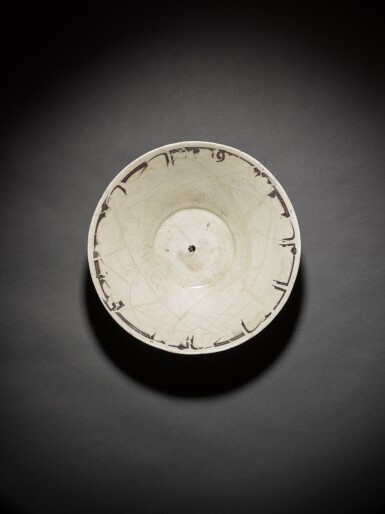
An impressive Samanid calligraphic bowl, Tashkent, 9th or early 10th century
Estimate
60,000 - 80,000 GBP
Lot Details
Description
of conical form on short foot, the earthenware body decorated in white slip with a single line of dark brown Kufic calligraphy around the rim, the exterior plain
36.5cm. diam.
inscription
around the rim: la khayr fi'l-mal idha lam yakun 'inda jawad al-kaff , ‘there is no goodness in wealth if it is not in the palm of the hand of a liberal one.’
Within the broader corpus of Samanid calligraphic earthenware ceramics from Central Asia, the present bowl can be identified with a group of ceramic vessels that recent scholarship has shown to be confidently attributable to Tashkent (Watson 2020, p.103, based on the extensive scholarship of Ilyasova et al., 2016). The city, variously known as Shash, Chach, or Binkath under the Samanids, had by the tenth century reached such size and grandeur that it could boast a walled inner city and citadel surrounded by further walled suburbs, beyond which laid a rich tapestry of orchards and gardens encompassed, as in Bukhara, by a third, sweeping ‘Great Wall’ (Le Strange 1905, pp.480-1).
The group of Samanid calligraphic earthenware to which the present bowl belongs is characterised by a white slip and a single inscribed line of austere but highly accomplished Kufic around the rim, the hastae curved into a fine point akin to the tip of a reed pen – the calligrapher’s tool – in profile.
That such Tashkent wares were highly regarded in their own time is shown by a passage in the Aḥsan al-taqāsīm fī ma‘rafat al-aqālīm (‘Best Divisions for Knowledge of the Climes’) of the tenth-century Arab geographer al-Maqdisi, who wrote that “nothing can compare […] with the bows (qasiyy) from Khwarazm, large bowls (ghaḍā’ir) from Shash, and paper (kāghad) from Samarqand” (Al-Maqdisi 1906, vol.2, p.326). As Oya Pancaroğlu writes, these wares “reflect the aspirations of a refined literary culture in their fusion of the sophistication of the calligraphy, the moral sentiments of the texts, and the high quality of a regionally developed ceramic production” (Pancaroğlu 2007, p.64).
Although the content of the inscriptions on Samanid calligraphic wares in this group is invariably described as defined broadly by “the virtues and ethics of generosity” (Pancaroğlu 2007, pp.64-65, cf. Watson 2004, p.206), with the exception of a few widely-distributed proverbs attributed to Muhammad or ‘Ali, very few have known sources (see Ghouchani 1364/1986), and they are thus hard to contextualise. The present bowl forms a rare exception to this rule, as it is inscribed with an adaptation of the first couplet of a quatrain by the famed eighth-century jurisprudent Ibn al-Mubarak (d.797 AD), which, in full, reads:
lā khayr fī al-māl wa-kunnāzihi bal li-jawād al-kaff wahhābihi
yaf‘al aḥyānan bi-zuwwārihi mā yaf‘al al-khamr bi-shurrābihi
‘There is no goodness in wealth and its hoarding / but with the generosity of an unrestrained hand’
‘On occasion it does with its pilgrims / what wine does with its drinkers’ (Divan of Ibn al-Mubarak 1432/2010-11, pp.43-44).
The same inscription also appears in slightly different form on three other vessels, two of which belong to the same group of Tashkent calligraphic wares. A fragment in the Mardjani Foundation, Moscow (inv.no. IM/K-156), and a restored fragmentary bowl formerly in the Harvey B. Plotnick Collection (Pancaroğlu 2007, pp. 66-7; sold in these rooms, 4 October 2011, lot 7) match the wording on the present bowl, with the latter maintaining the word wahhāb of Ibn al-Mubarak’s couplet. The third, a curious fragmentary bowl attributable to ninth-century Iraq, was sold in these rooms, 25 April 1996, lot 38 (Ilyasova 2016, pp.455-8).
The choice of Ibn al-Mubarak in many ways confirms that these fine calligraphic wares reflect aspirations of literary refinement and ethical conduct. Although a prominent Sunni jurisprudent, Ibn al-Mubarak was famed in his time for his ‘Book on Temperance’ (Kitāb al-zuhd), an important text on piety and ethics and a precursor to later Sufi texts that emphasised a more “moderate trend of piety that did not detach itself from the world completely” (Salem 2016, pp.105-9). In addition to his scholarly and poetic pursuits, Ibn al-Mubarak was a successful merchant and a lauded ghāzī whose generosity extended beyond words on a page. Al-Hasan b. al-Rabi‘ related that he accompanied Ibn al-Mubarak from Merv to Baghdad and never saw him eat a meal without inviting a guest to eat with him, and that “we had never seen [among ascetics] al-zamaward (a food made with meat and eggs) except with Ibn al-Mubarak in Kufa. He used to buy food and invite the people of ḥadīth. He then spread a cloth and put clothes lengthwise so that it can be eaten upon” (Salem 2016, pp.111-2). For the generous host, it is therefore hard to conceive of a more suitable poem or poet for this large and luxurious article of tableware.
You May Also Like

![An extremely rare illustrated manuscript of the Ka'banameh (A history of the Ka'ba) by Abdulrahman Gubari (d.1566), signed by Ahmad [...] al-Khatib, Kaposvár, Hungary, dated Dhu'l-Hijjah 1080 AH/April-May 1670 AD](https://dam.sothebys.com/dam/image/lot/1e33ac28-a449-4673-a23f-f1ca4d5a13b3/primary/extra_small)








